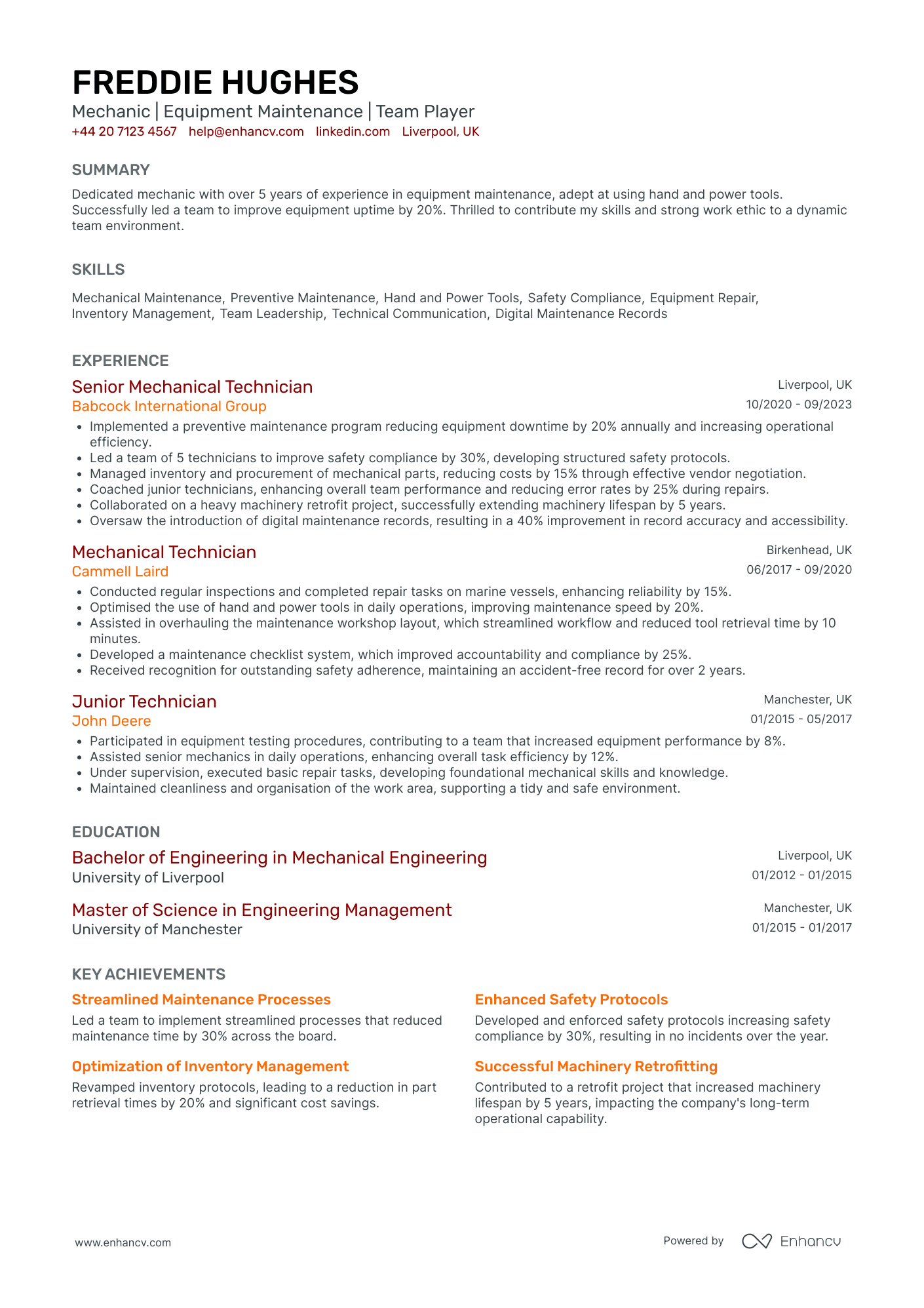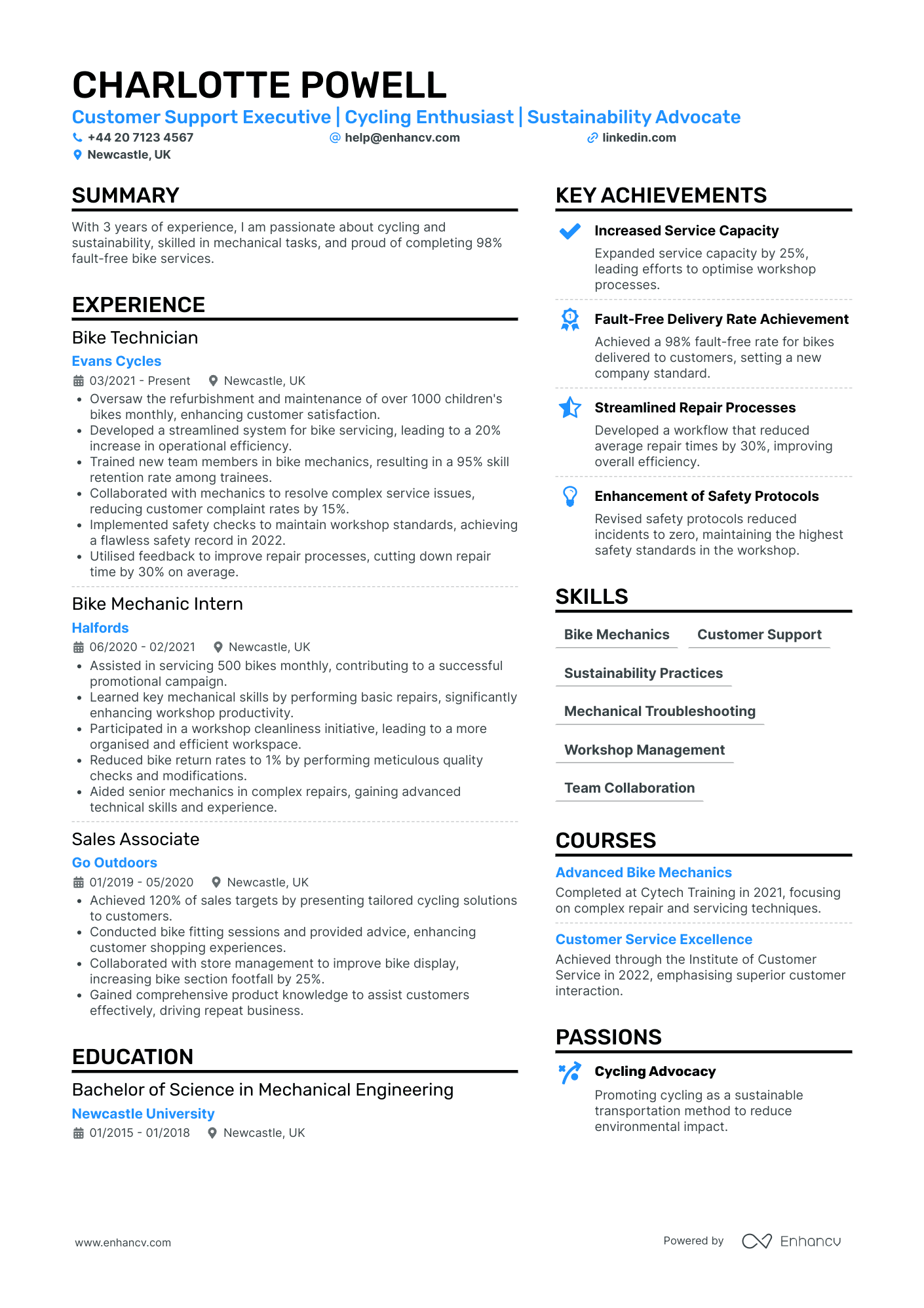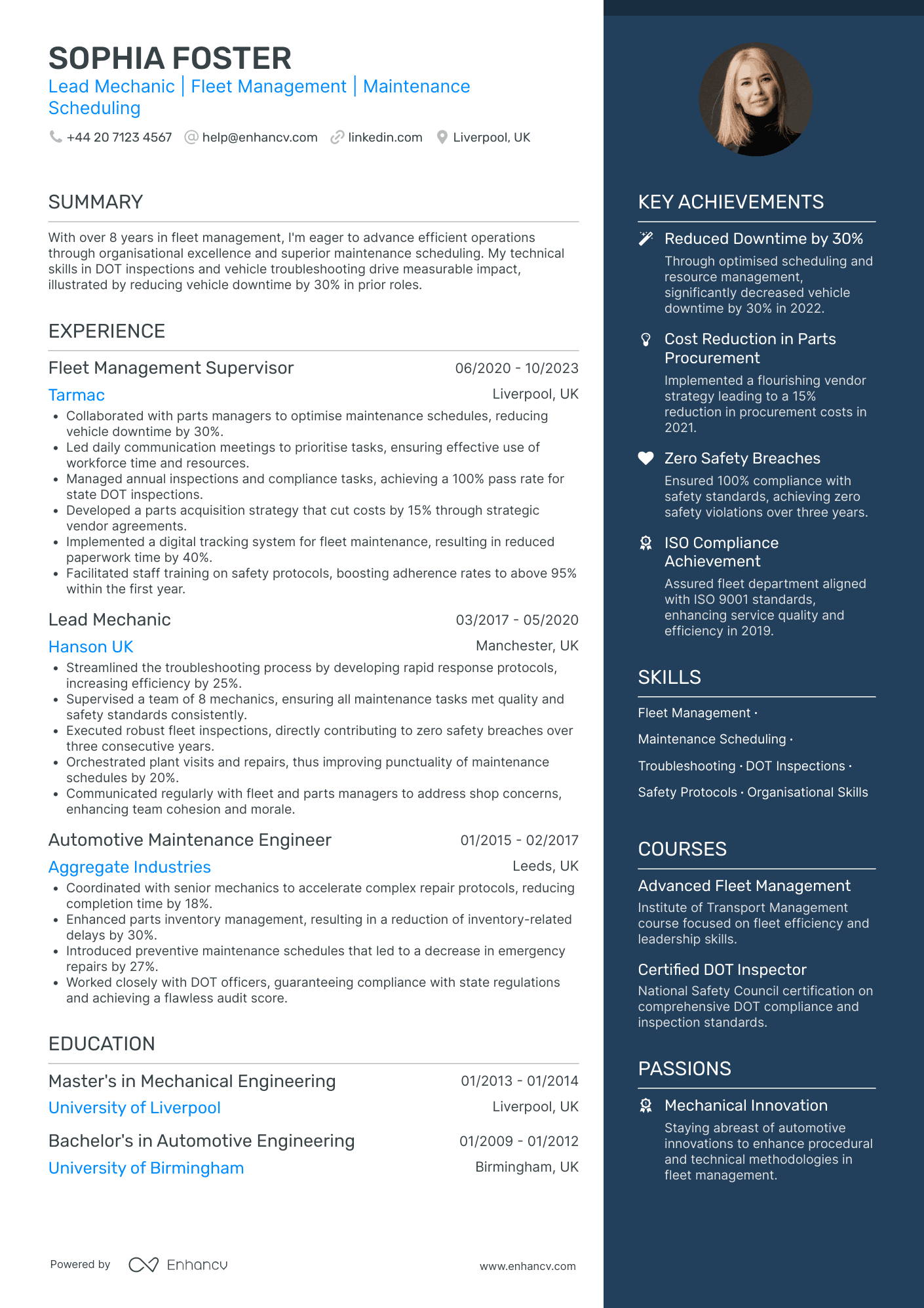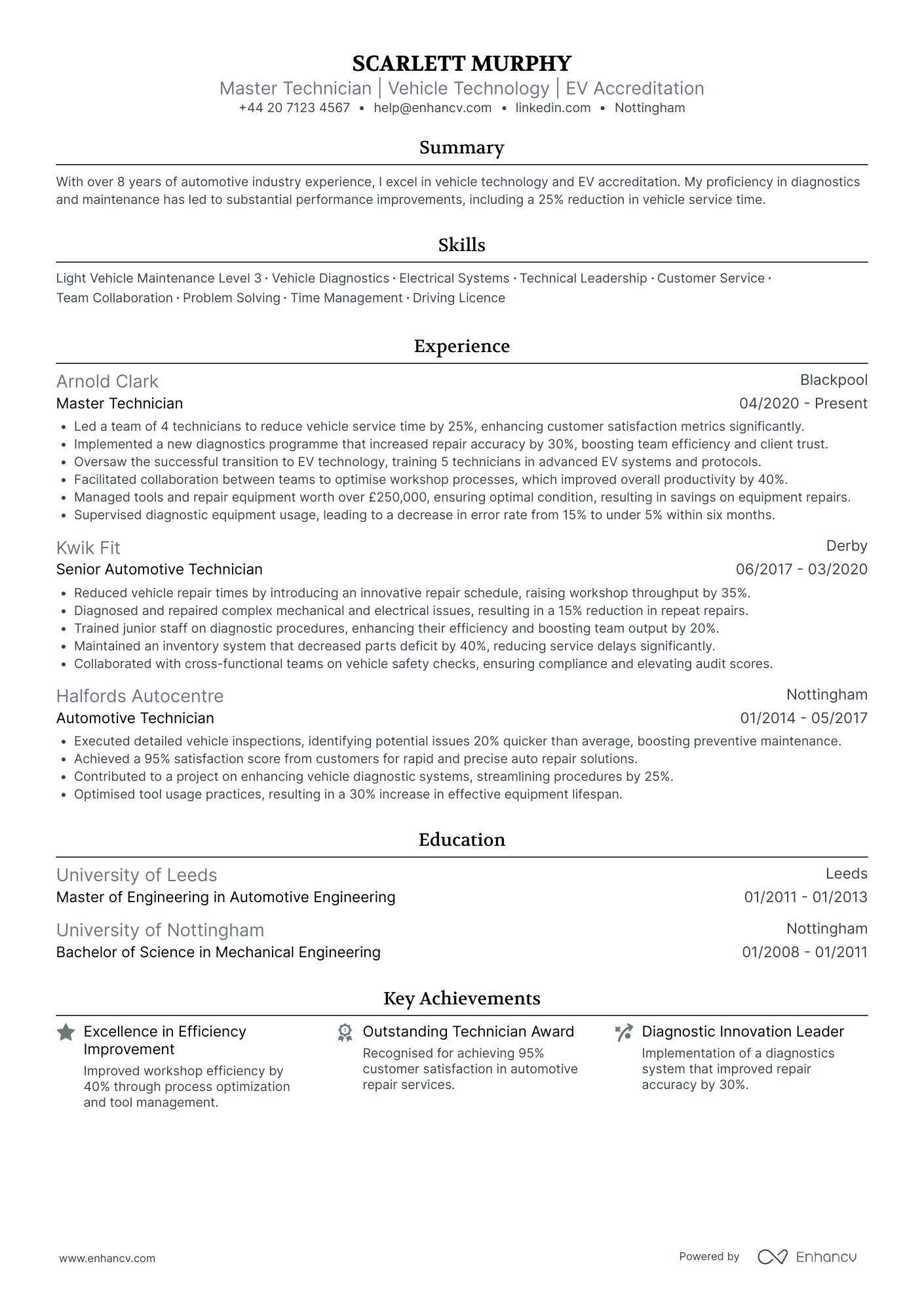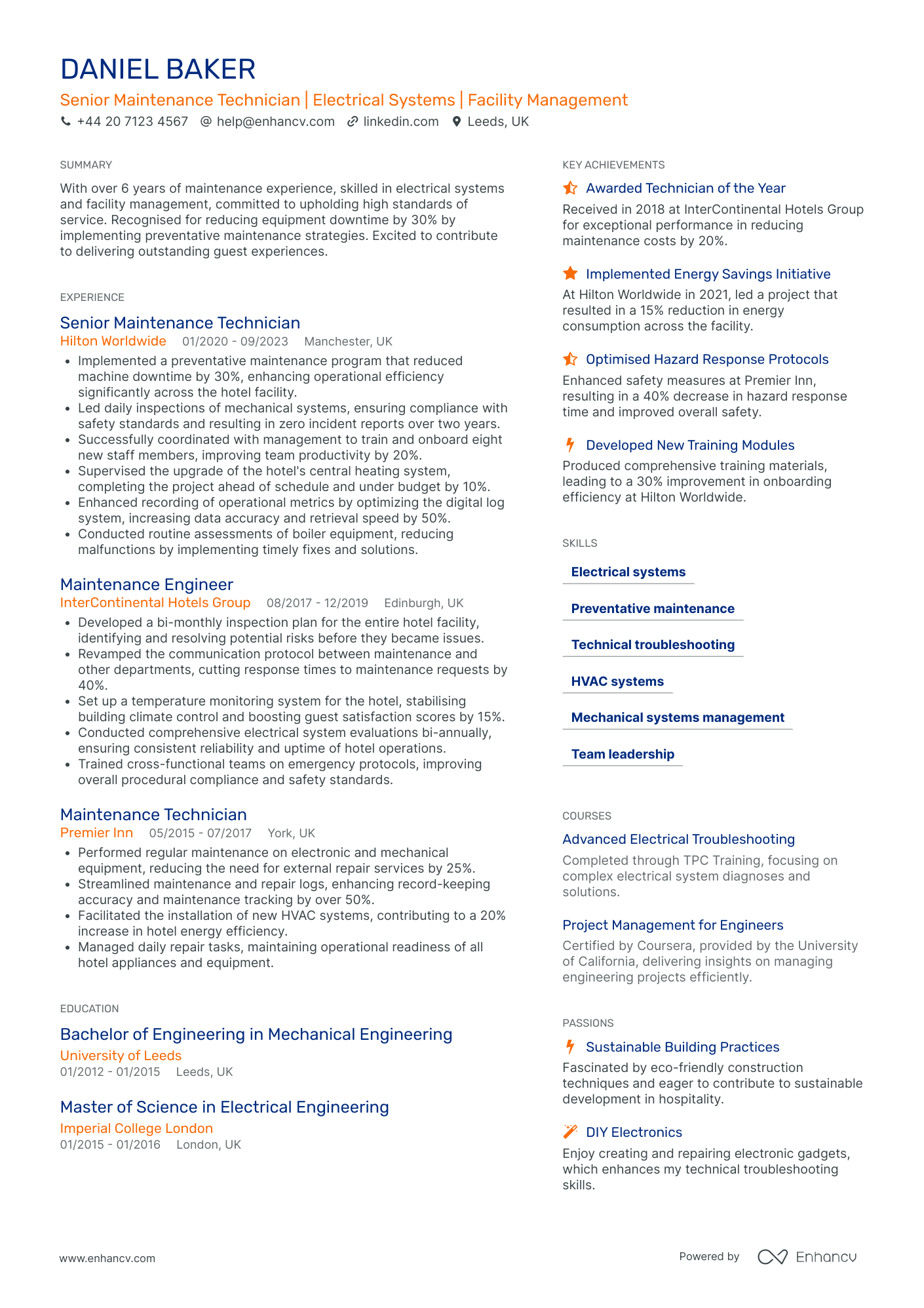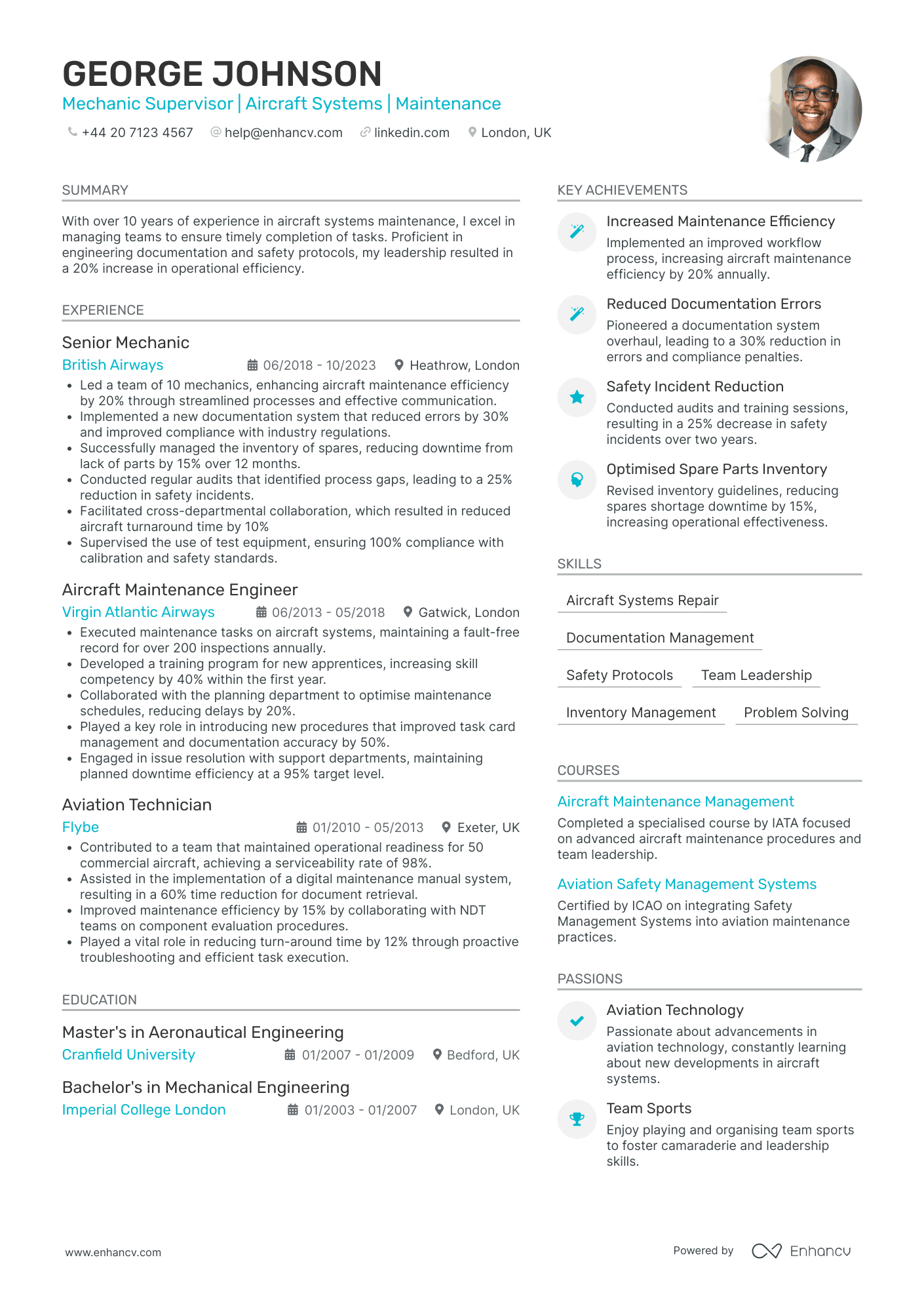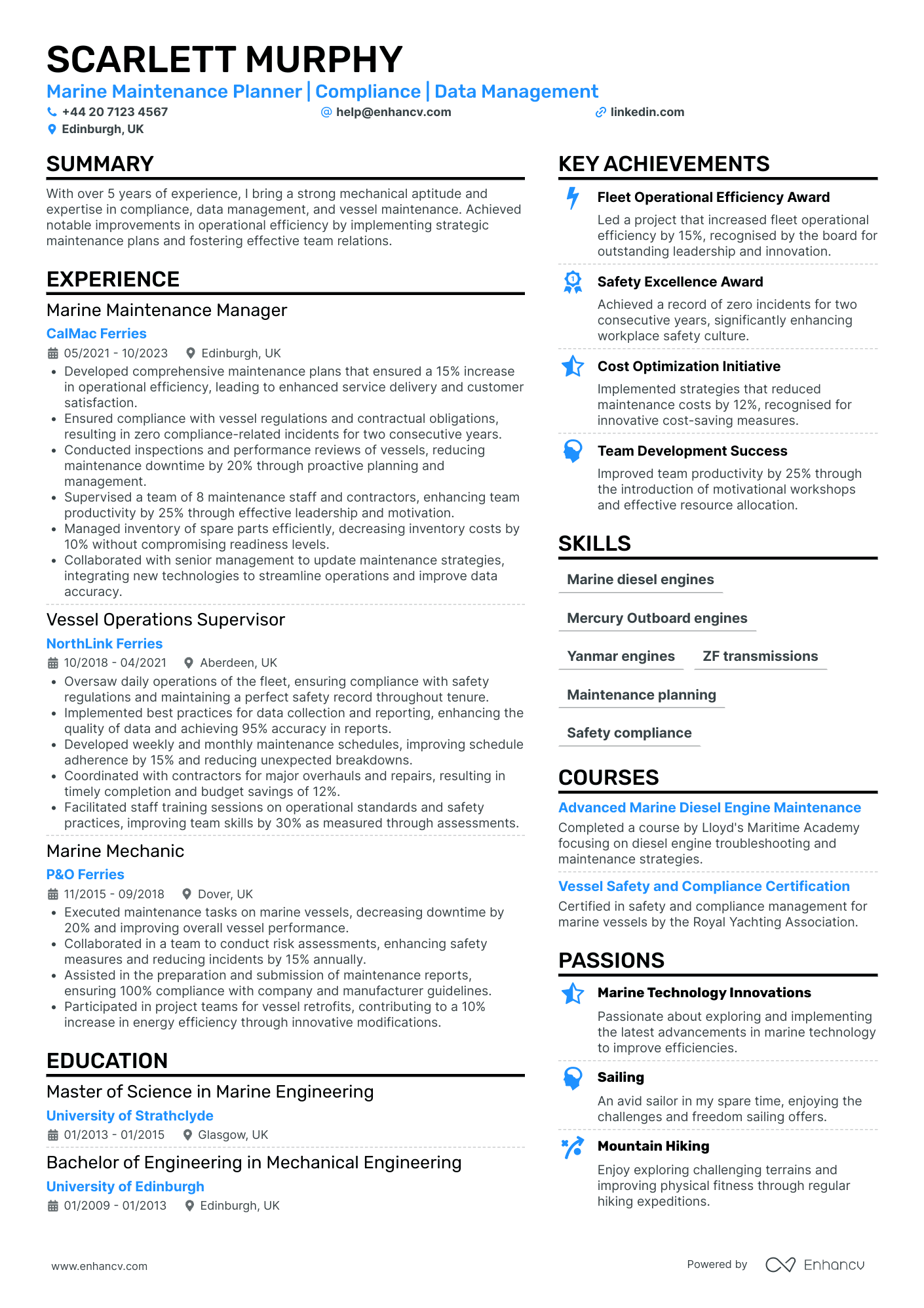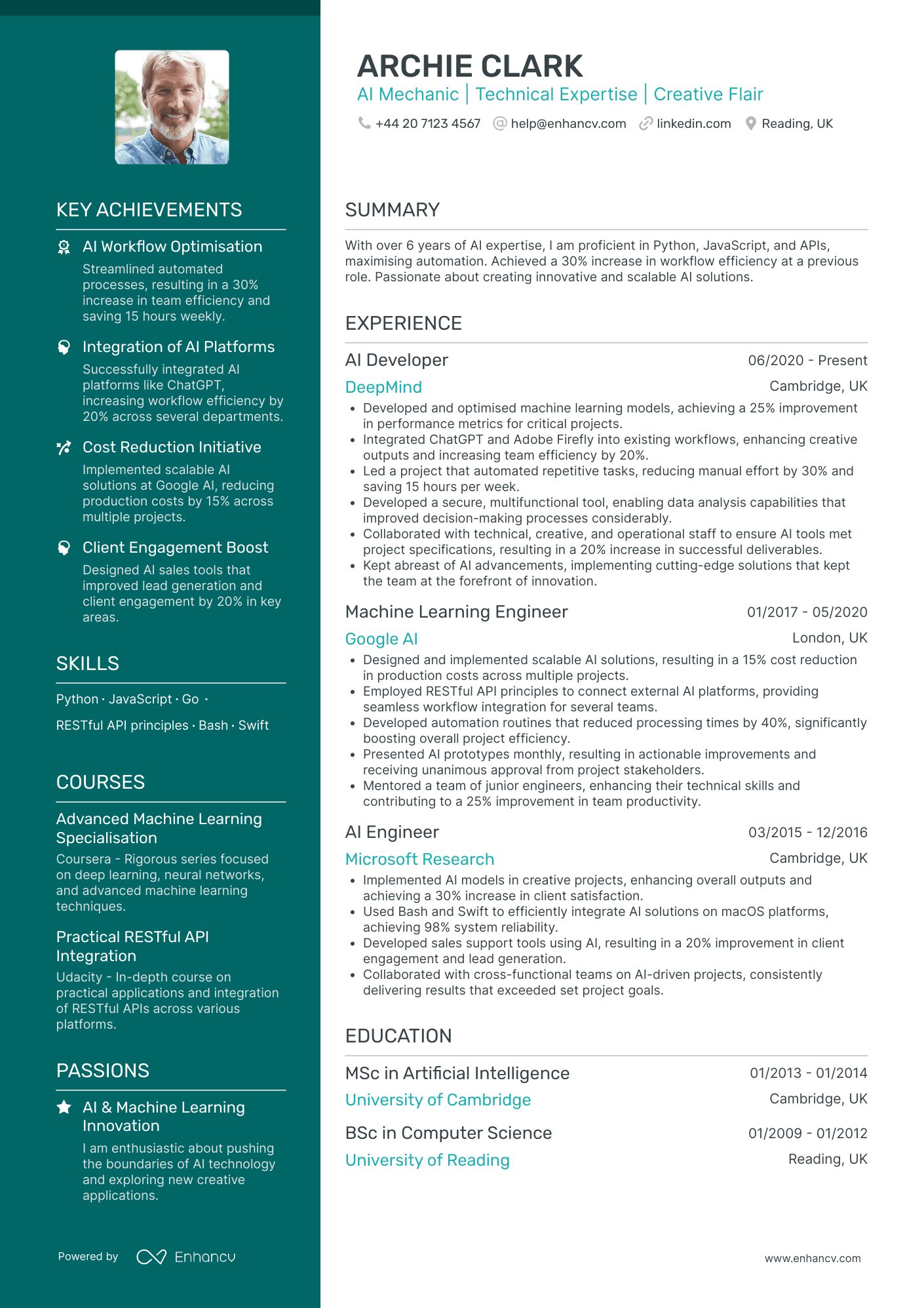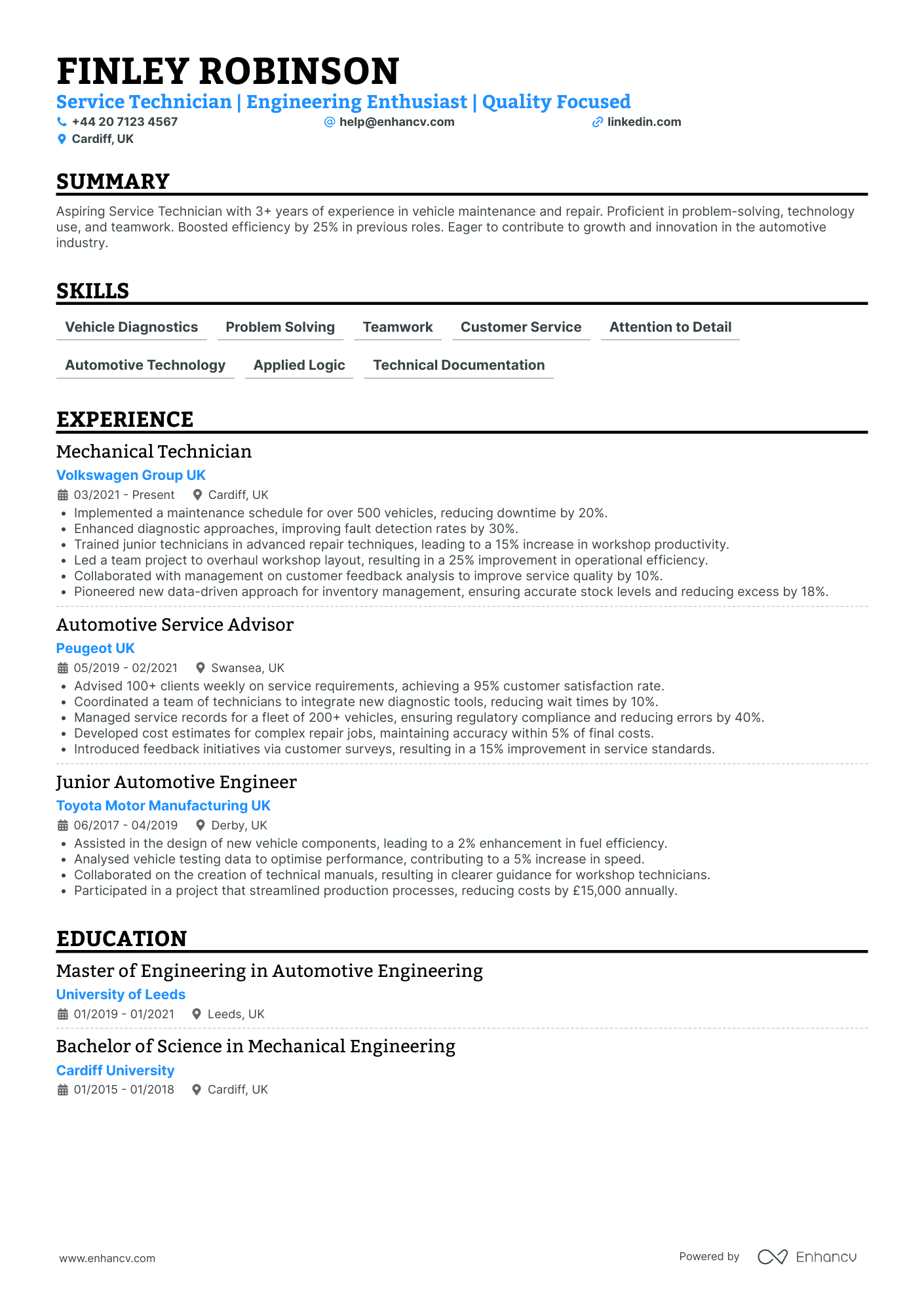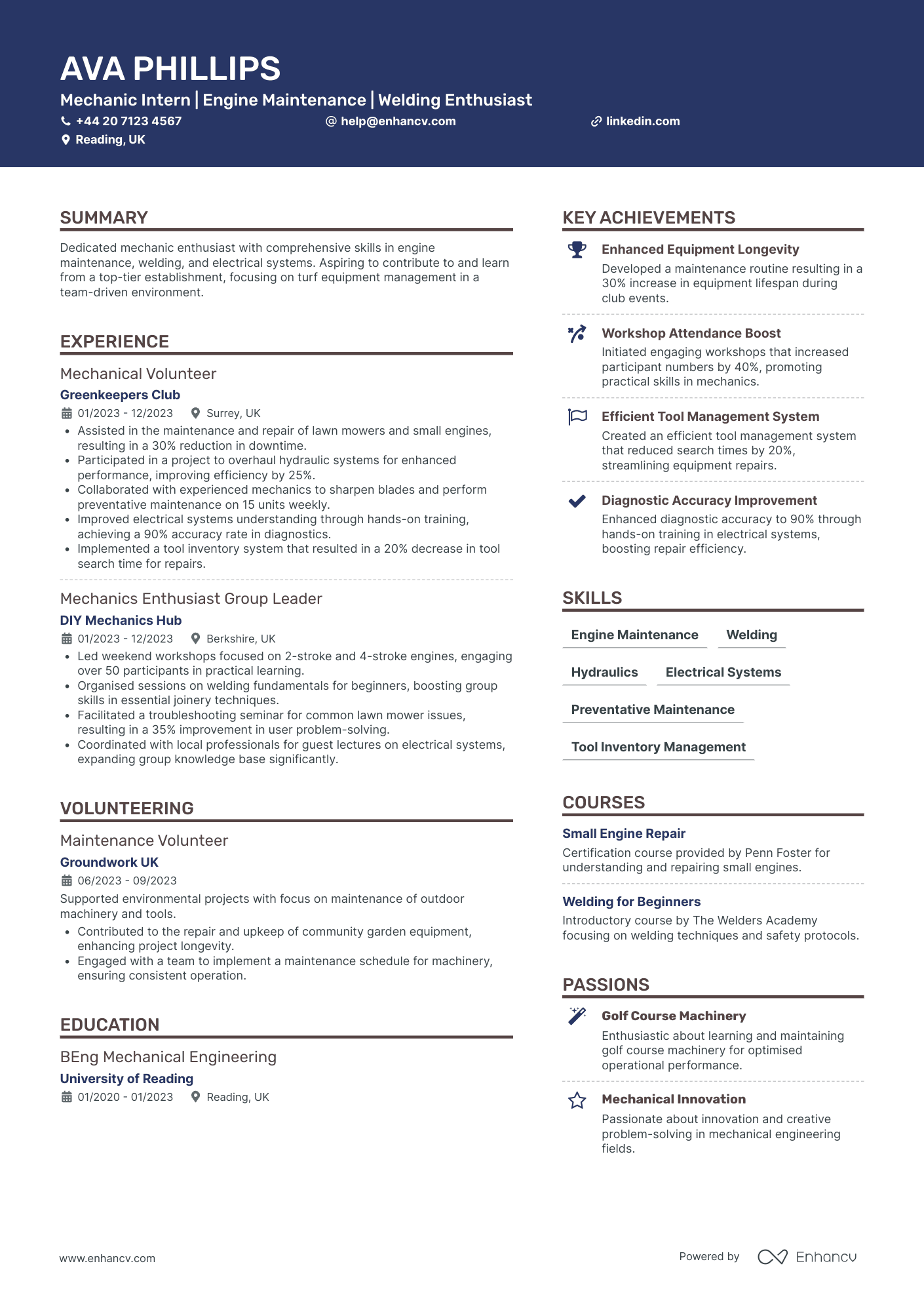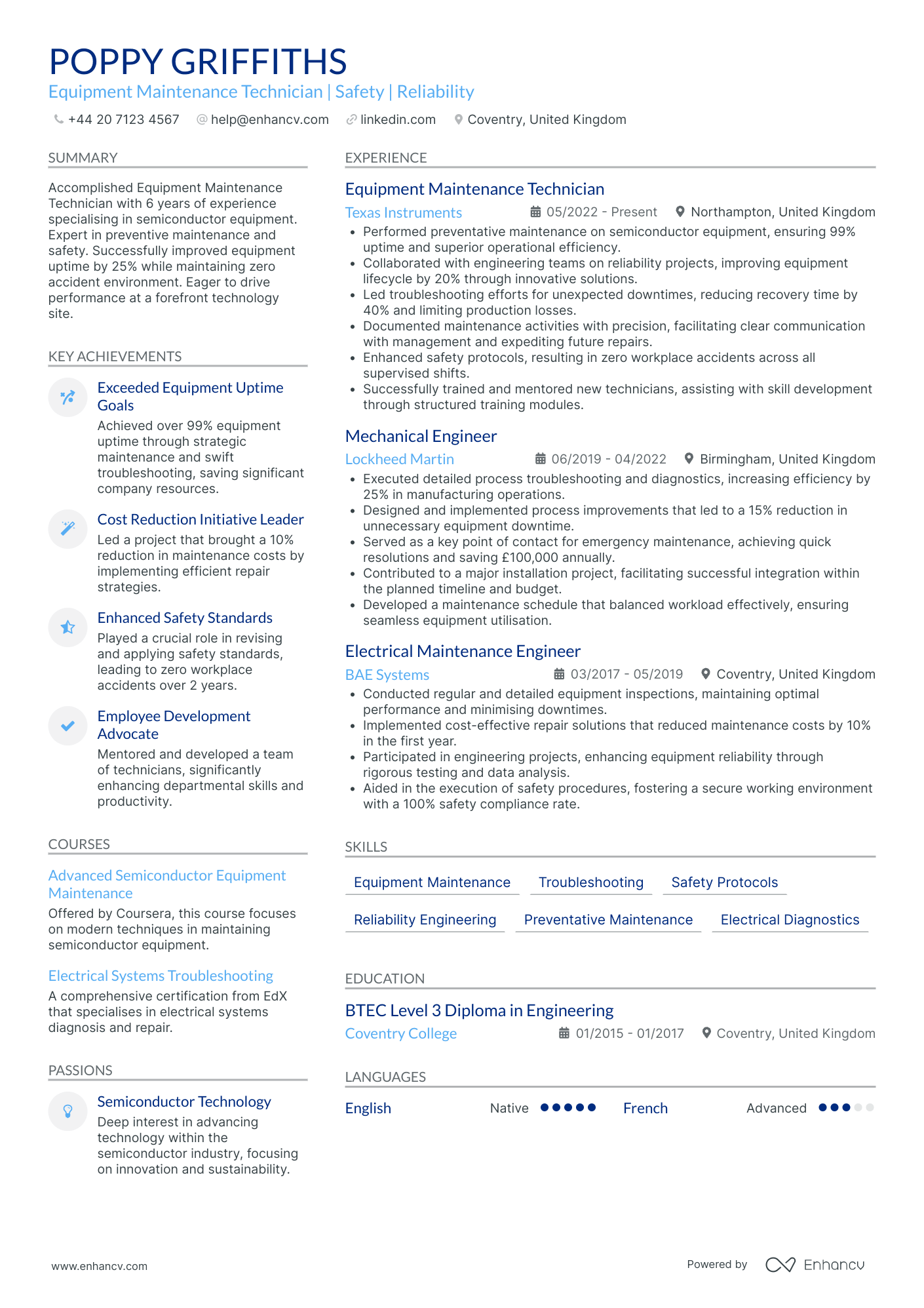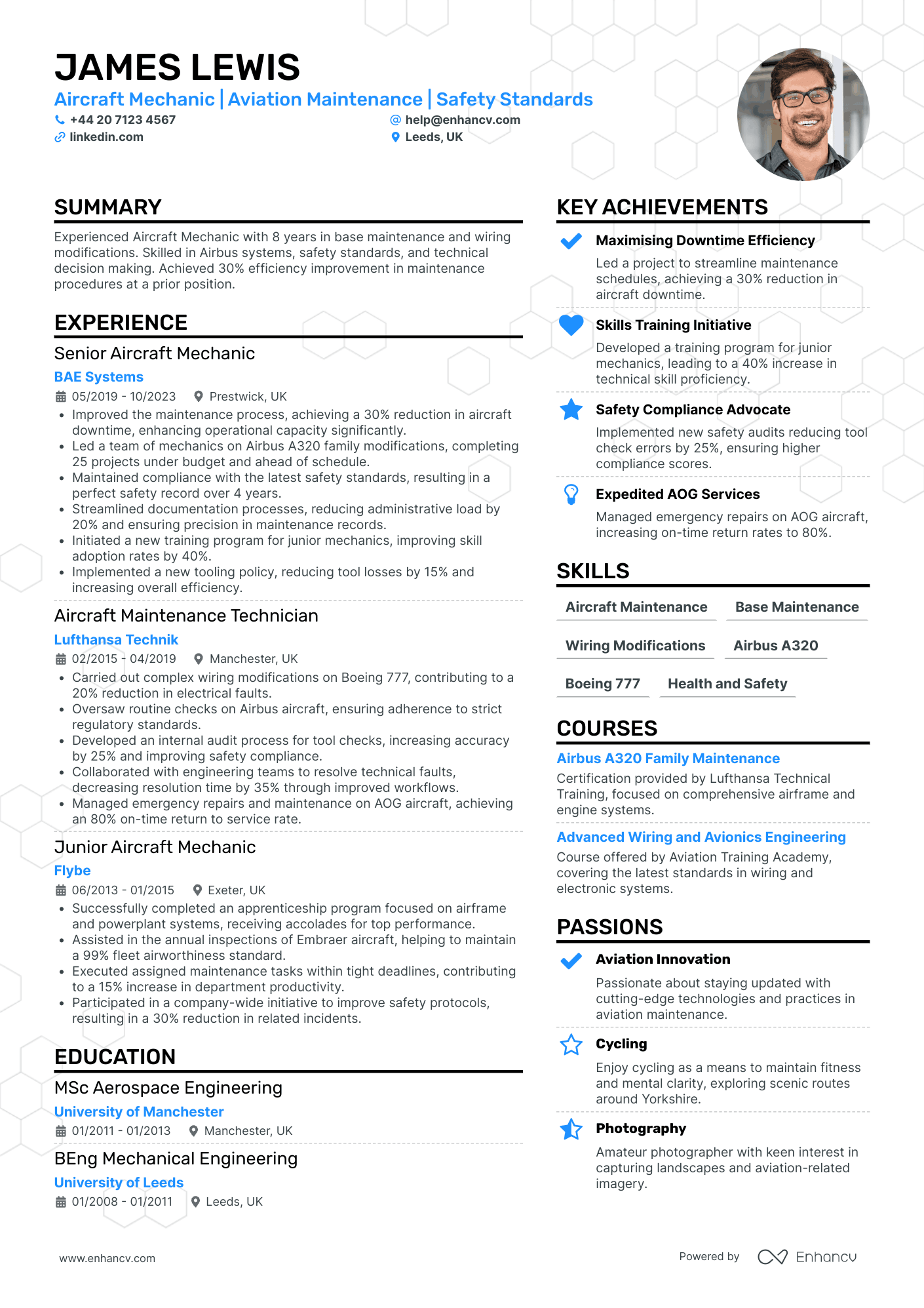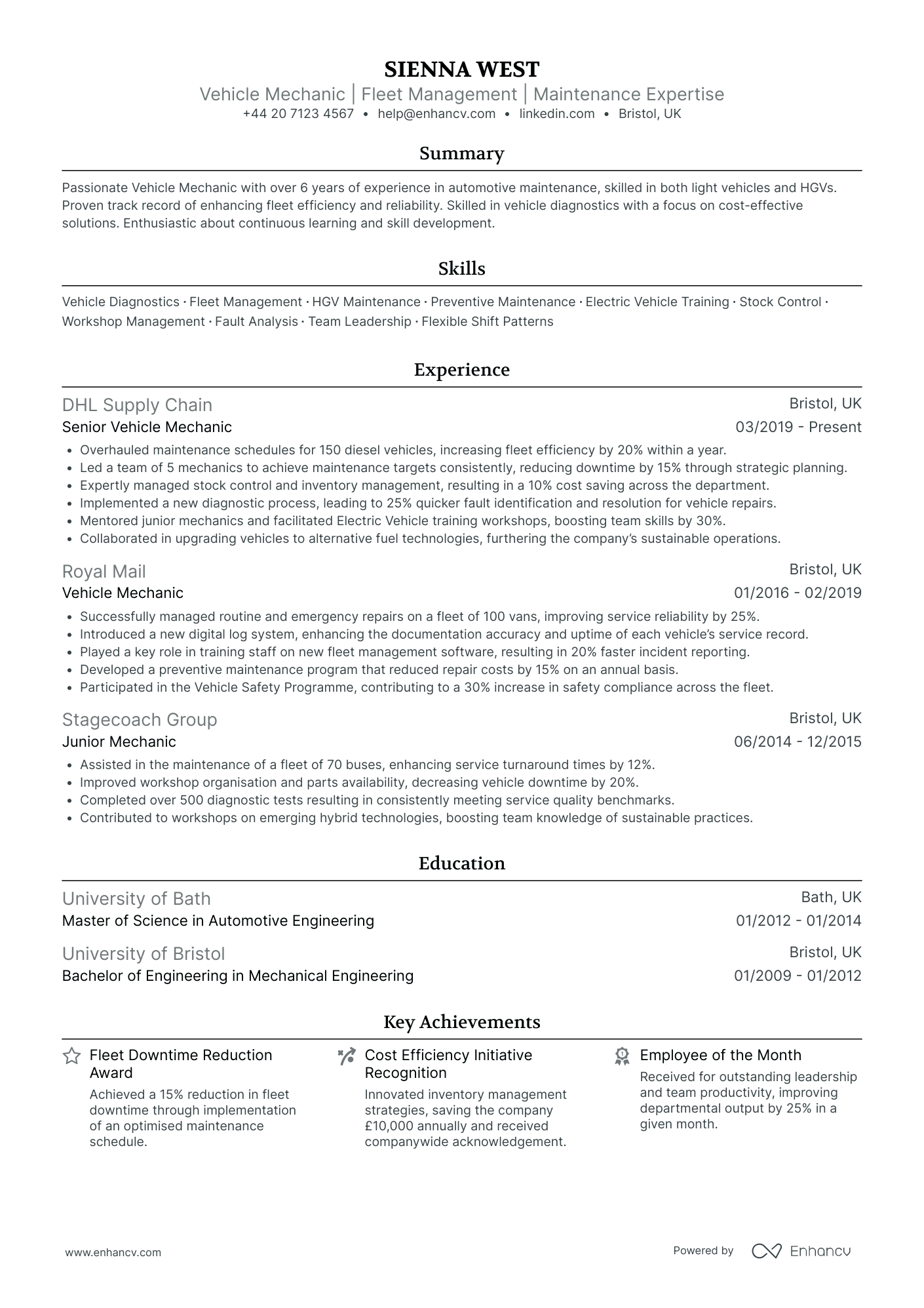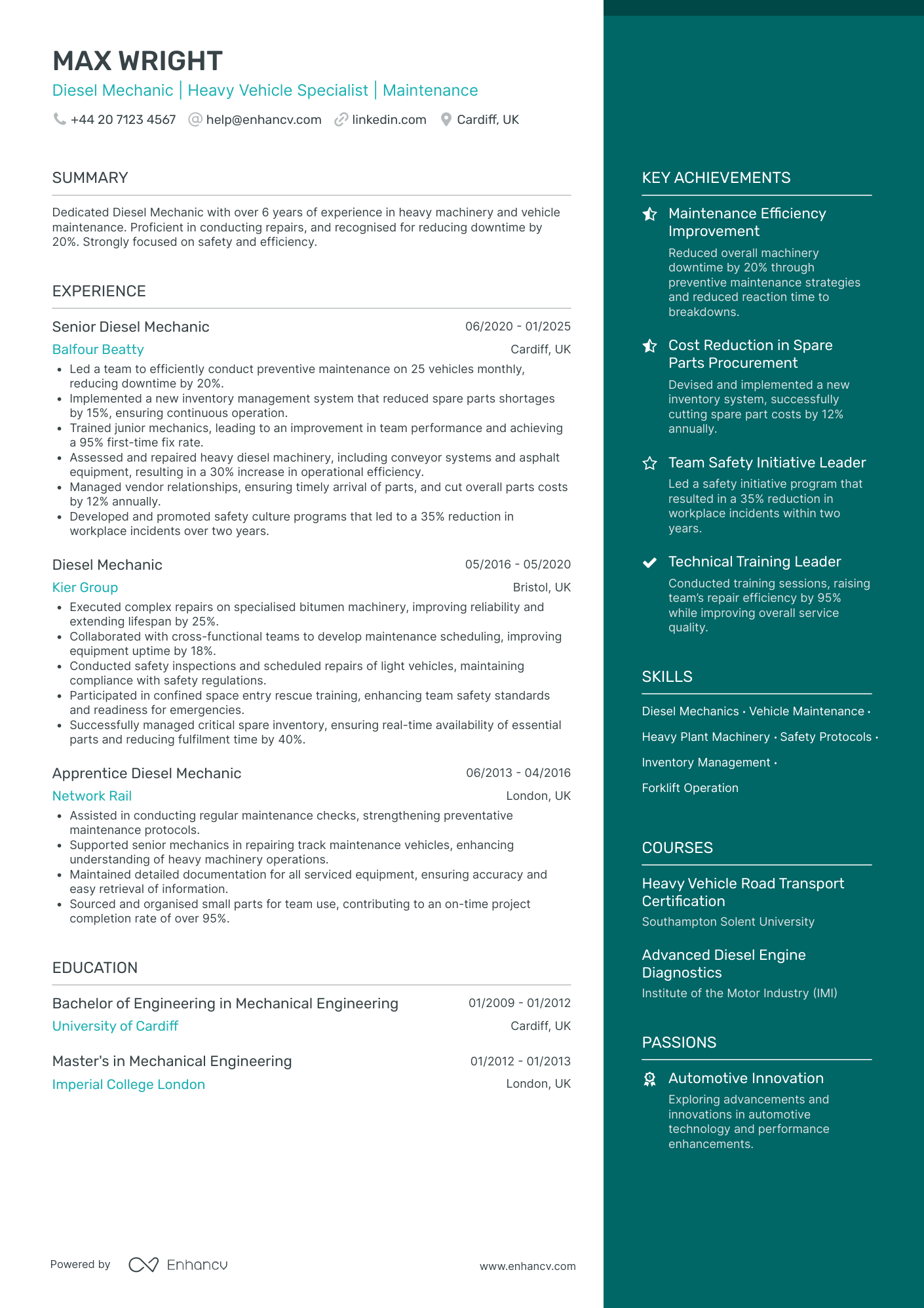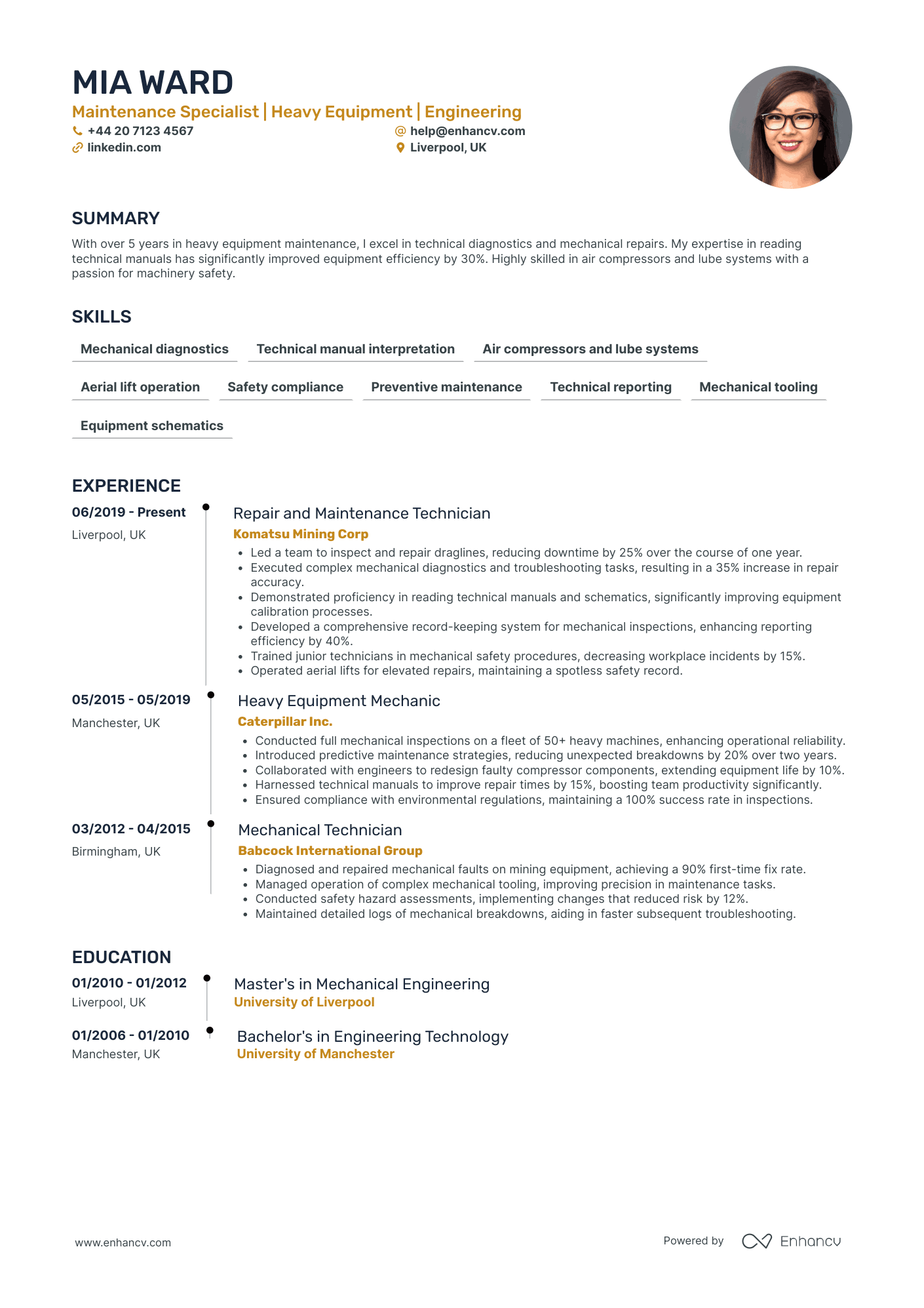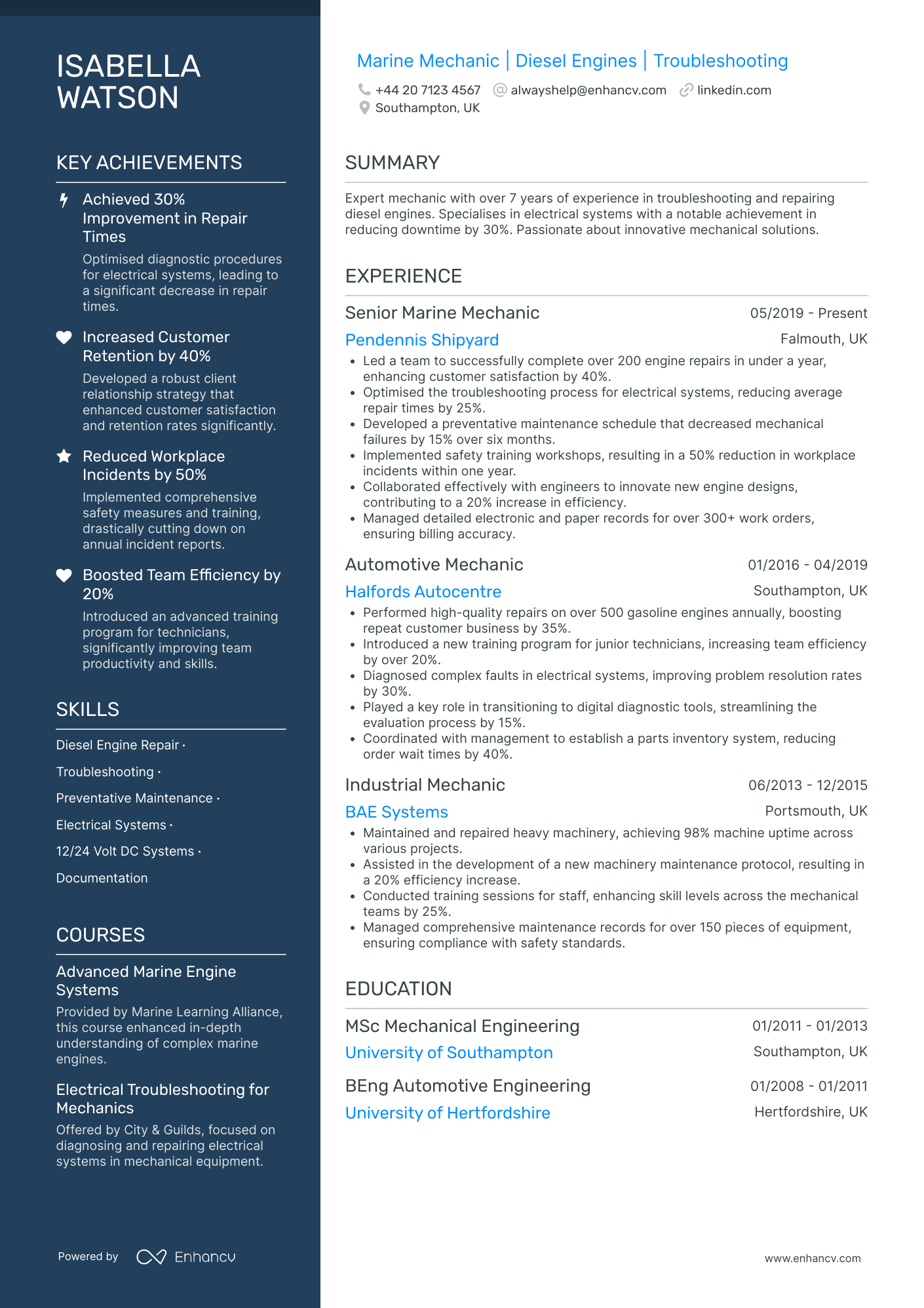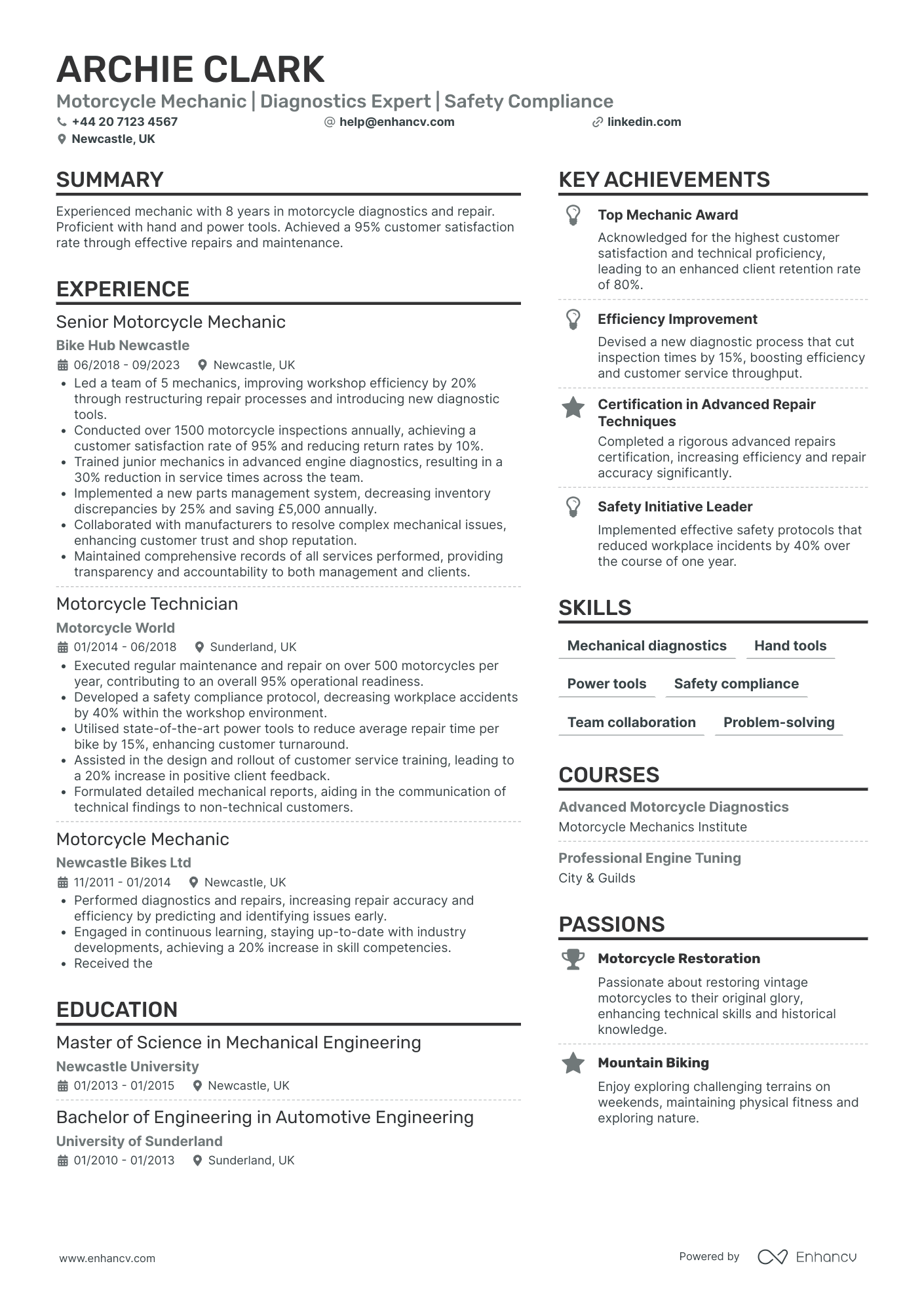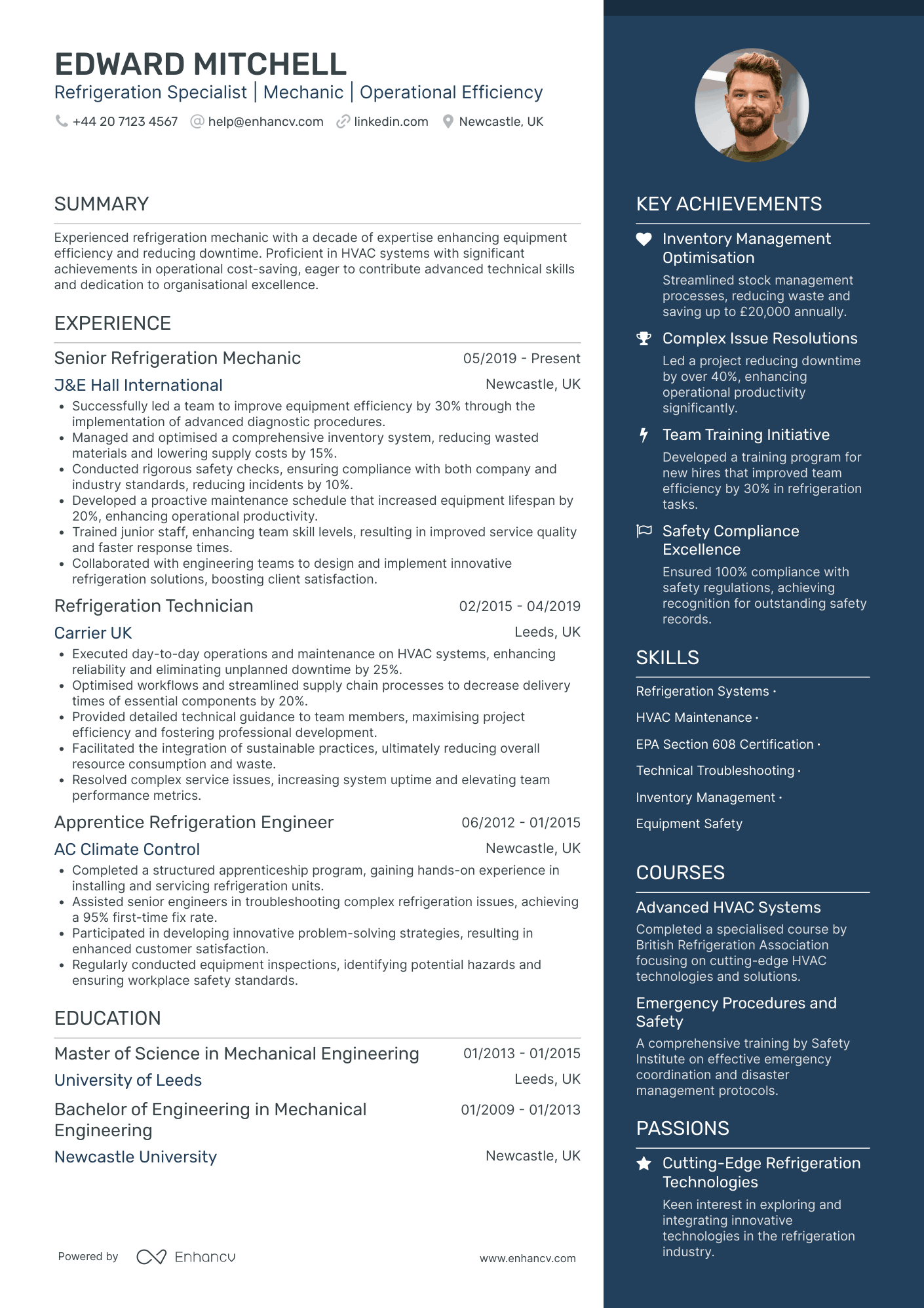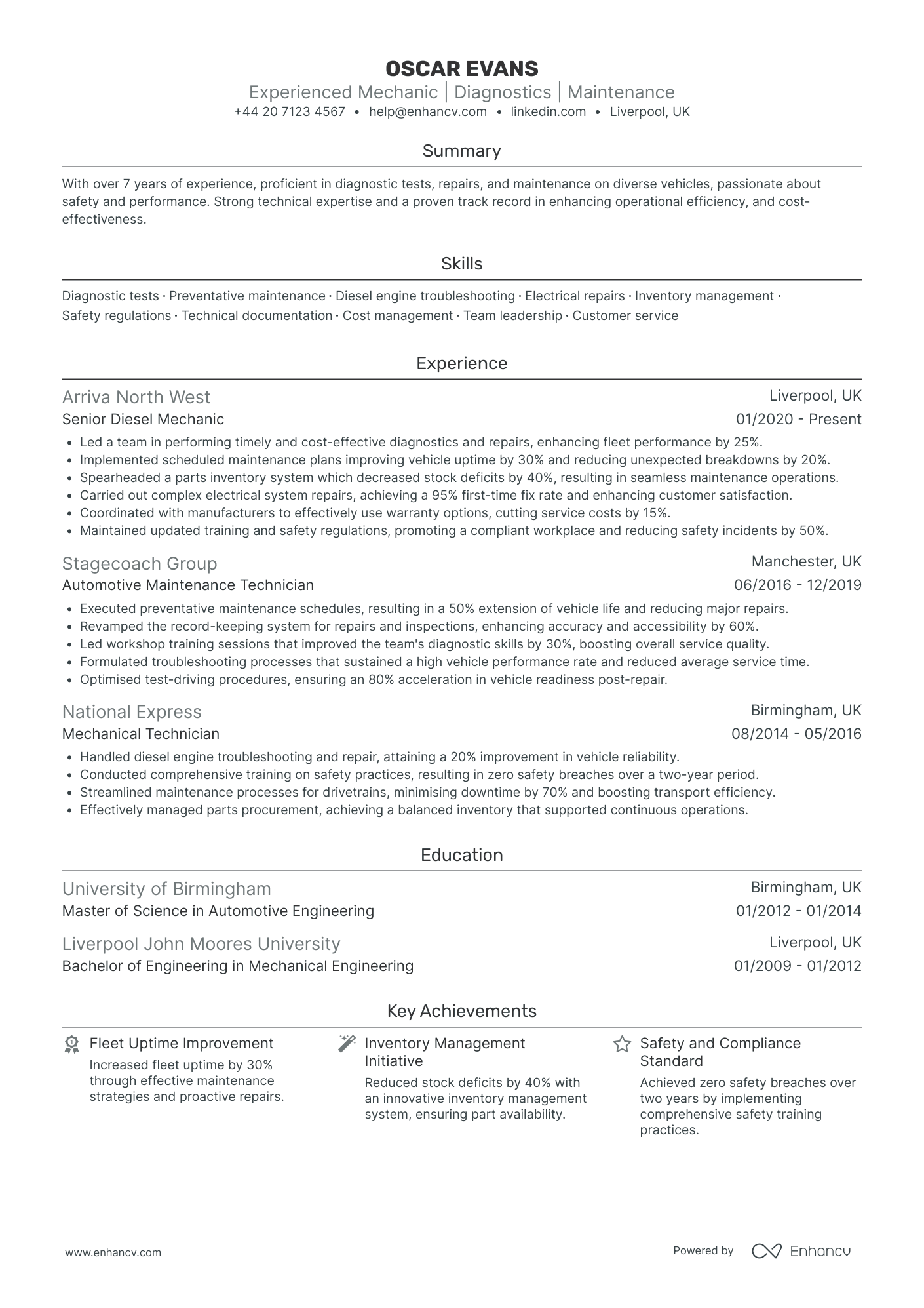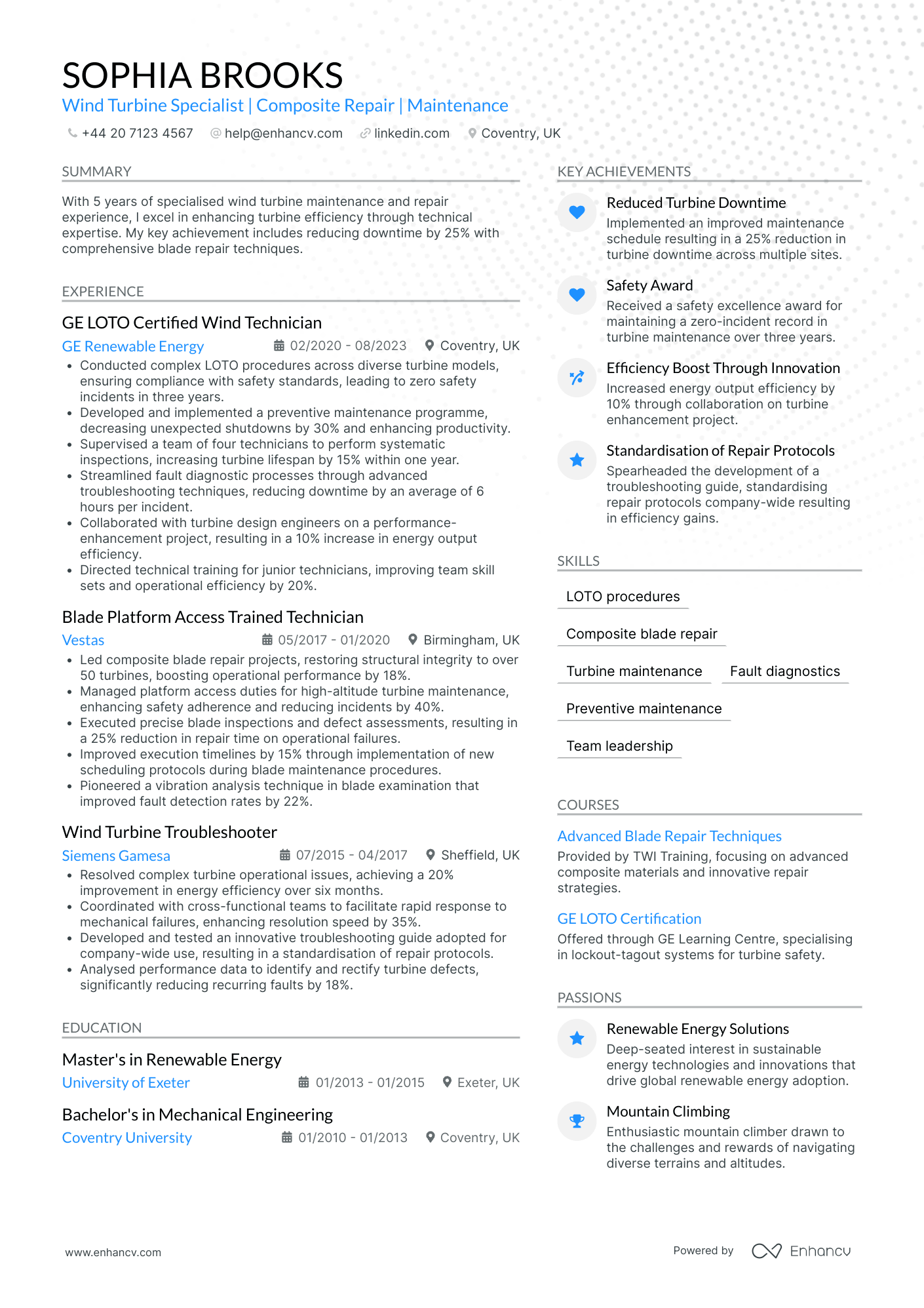Navigating the competitive job market can be daunting for a mechanic, with particular challenges in tailoring a curriculum vitae to showcase technical expertise and hands-on experience effectively. Our guide provides step-by-step advice on presenting your skills and qualifications in a manner that captures the attention of employers and stands out in a sea of applicants.
- Design and format your professional mechanic CV;
- Curate your key contact information, skills, and achievements throughout your CV sections;
- Ensure your profile stays competitive by studying other industry-leading mechanic CVs;
- Create a great CV even if you happen to have less professional experience, or switching fields.
When writing your mechanic CV, you may need plenty of insights from hiring managers. We have prepared industry-leading advice in the form of our relevant CV guides.
CV examples for mechanic
By Experience
Entry-Level Mechanic
- Comprehensive Career Progression - The CV effectively illustrates Freddie Hughes' professional journey, revealing a clear trajectory of development from a Junior Technician to a Senior Mechanical Technician. This progression demonstrates his dedication to the field and ability to take on increased responsibilities over time.
- Detailed Technical Acumen - The document showcases Freddie’s proficiency with industry-specific tools and methodologies such as preventive maintenance, digital maintenance records, and heavy machinery retrofitting. This technical depth indicates his solid foundation in mechanical maintenance as well as his capacity to adapt to new technologies and practices.
- Emphasis on Leadership and Team Development - Freddie’s ability to lead teams effectively is underscored by his achievements in coaching junior technicians and successfully managing a team of five. These experiences highlight his interpersonal skills and his contribution to fostering a productive and compliant work environment.
Junior Mechanic
- Clear career trajectory with progressive growth - The CV demonstrates a clear progression in the bicycle-related industry from a sales associate to a bike mechanic intern, and then to a bike technician role. This trajectory highlights the candidate’s increasing responsibilities and expertise in bike mechanics and customer service, showcasing growth and specialization.
- Rich technical depth and industry-specific skills - Charlotte's CV stands out by detailing specific mechanical and operational skills relevant to the bicycle industry. Her ability to develop streamlined servicing systems and implement safety checks demonstrates a technical depth that is not only industry-specific but also essential for optimizing workshop operations and customer satisfaction.
- Focused achievements with quantifiable impact - The achievements listed are not only quantitative but also illustrate the broader business impact. For example, improving operational efficiency by 20% and achieving a 98% fault-free delivery rate are metrics that emphasize her contribution to enhancing service quality and customer satisfaction, which are crucial in a technical support role.
Lead Mechanic
- Structured showcase of experience and progress - The CV presents a clear trajectory of career growth, detailing Sophia's rise from an Automotive Maintenance Engineer to her current role as Fleet Management Supervisor. This structured approach emphasizes her increasing responsibilities and contributions to the field of fleet management.
- Industry-specific technical skills and methodologies - The document highlights unique elements such as DOT inspections, preventive maintenance schedules, and digital tracking systems, each detailed with quantifiable outcomes. These specifics demonstrate the candidate’s technical depth and contributions to operational efficiencies in her industry.
- Demonstrated leadership and soft skills - Sophia's leadership qualities are underscored by her roles in staff training, team supervision, and her ability to enhance team cohesion and morale. Her soft skills shine through her accomplishments in orchestrating team activities and achieving remarkable compliance and safety adherence.
Master Mechanic
- Innovative Diagnostics Implementation - Scarlett Murphy’s CV highlights her unique ability to implement innovative diagnostic programs, evidenced by a 30% increase in repair accuracy. This showcases her technical acumen and her contribution to enhancing overall team efficiency.
- Career Advancement and Industry Expertise - The progression from an Automotive Technician to a Master Technician reflects consistent career growth in vehicle technology and EV systems, with each role demonstrating an increase in responsibility and expertise, showing her dedication to the industry.
- Leadership and Collaboration Proficiency - Her capacity to lead and collaborate is evident through roles such as supervising teams, managing expensive equipment, and optimizing workshop processes. Such soft skills enhance her effectiveness in improving team productivity and customer satisfaction.
Senior Mechanic
- Comprehensive career growth and expertise - Daniel Baker's CV illustrates a clear career trajectory, showcasing growth from a Maintenance Technician to a Senior Maintenance Technician. This progression, particularly within leading hotel brands like Hilton and InterContinental, indicates a deepening of expertise in maintenance and facility management, culminating in substantial responsibility and leadership in his recent role.
- Effective use of achievements and metrics - The CV excels in quantifying achievements, providing metrics like reducing equipment downtime by 30% and enhancing guest satisfaction scores by 15%. These metrics not only highlight Daniel's capability in improving operational efficiencies but also connect his individual contributions to broader business outcomes, such as cost reduction and improved customer experiences.
- Integration of technical and soft skills - The document balances technical proficiency in electrical systems, HVAC management, and preventative maintenance with soft skills such as team leadership and project management. This integration indicates an ability to apply technical knowledge while leading teams and managing projects, making Daniel a versatile asset in maintenance and facility management roles.
Mechanic Supervisor
- Strategic Career Progression - George Johnson's career trajectory highlights a seamless progression from Aviation Technician to a Senior Mechanic and eventually a Mechanic Supervisor. This advancement reflects a solid foundation in technical skills and leadership aptitude, showcasing his capability to handle increasing responsibilities within the aviation maintenance sector.
- Cross-Functional Leadership and Collaboration - The CV details George's ability to lead and work collaboratively across departments, which has directly contributed to operational improvements such as a reduction in aircraft turnaround time and increased maintenance efficiency. His skills in fostering collaboration are essential for ensuring cohesive team dynamics and successful project delivery within complex operational environments.
- Emphasis on Safety and Compliance - George's focus on safety protocols and compliance stands out, as evidenced by the significant reduction in safety incidents and improvements in documentation accuracy. These achievements underline his commitment to maintaining high industry standards and ensuring regulatory compliance, which is critical in the aviation industry.
Mechanic Manager
- Articulately Structured Presentation - The CV is exceptionally well-organized, starting with a concise header that provides a quick overview of the candidate’s identity and contact details. Each section flows logically and is clearly labeled, ensuring that potential employers can easily navigate and absorb the information. The summary succinctly sets the stage for the depth of the candidate's expertise in marine maintenance and compliance.
- Steady Career Advancement in the Marine Industry - Scarlett Murphy's career trajectory demonstrates a clear path of growth within the marine sector, advancing from a Marine Mechanic to Marine Maintenance Manager within prominent ferry companies. This progression is indicative of her expanding responsibilities and her ability to thrive in more complex roles over time, showcasing her dedication and competence in her field.
- Impactful Achievements in Operational Efficiency - The CV stands out with its focus on tangible achievements, like improving operational efficiency by 15% and maintaining a perfect safety record, emphasizing the candidate’s ability to deliver significant business improvements. These accomplishments are not just numbers; they highlight Scarlett's capacity to enhance service quality and safety standards, directly correlating to increased customer satisfaction and cost efficiency.
Mechanic Director
- Effective Content Presentation - The CV is well-structured with clear sections including experience, education, skills, and achievements. Each section is concise and focused, making it easy for readers to quickly understand the candidate's qualifications and accomplishments.
- Dynamic Career Trajectory - Archie Clark's career shows a clear progression from an AI Engineer to an AI Developer, with significant roles at leading companies like Microsoft, Google, and DeepMind. This trajectory highlights their growth in technical responsibilities and their increasing impact on business outcomes.
- Adaptability and Cross-Functional Collaboration - The CV underscores Archie's ability to work across different teams and industries, integrating AI platforms and collaborating with diverse professionals to achieve project goals. This versatility is further demonstrated by their engagement in both technical and creative projects.
Mechanic Apprentice
- Structured and Concise Presentation - The CV is exceptionally well-organized, presenting information clearly and concisely. Each section is methodically laid out, with bullet points used effectively to highlight key accomplishments and responsibilities. This clarity ensures that potential employers can quickly grasp the candidate's qualifications and suitability for the role of Service Technician.
- Strong Career Growth in the Automotive Sector - Finley Robinson's career trajectory displays significant progression within the automotive industry. Moving from a Junior Automotive Engineer to roles with increasing responsibilities such as Mechanical Technician and Automotive Service Advisor, this progression underscores Robinson's commitment and adaptability, aligning well with industry expectations for career advancement.
- Impressive Industry-Specific Achievements - The CV highlights unique contributions and impressive achievements within the automotive industry, such as implementing a maintenance schedule that reduced vehicle downtime by 20% and pioneering new diagnostic approaches. These accomplishments not only demonstrate technical expertise but also reveal a proactive approach to enhancing operational efficiency and service quality.
Mechanic Intern
- Structured Experience and Achievements - The CV is presented in a well-organized manner, clearly segmenting each section for easy navigation. The results-driven experience is accompanied by concrete achievements, such as reducing downtime by 30% and coordinating engaging workshops that increased participation by 40%, underscoring Ava's tangible contributions and growth in the field.
- Emphasis on Diverse Mechanical Skills - There is a strong emphasis on industry-specific skills like engine maintenance, welding, and hydraulics, demonstrating Ava's technical prowess. The CV meticulously details her hands-on experience with lawn mowers and small engines, making it evident that she possesses a deep understanding of mechanical systems, essential for the role of Mechanic Intern.
- Commitment to Professional Development - Ava's dedication to her career is highlighted through her participation in certification courses and voluntary positions, showcasing her proactive approach to learning. Her role as a group leader in the DIY Mechanics Hub and volunteering experience with Groundwork UK underscore her commitment to expanding her skills and knowledge in mechanical engineering and equipment maintenance.
Mechanic Specialist
- Structured Clarity - The CV is meticulously organized, presenting information in a clear and logical manner. Sections are well-defined, making it easy for readers to quickly grasp the candidate's experience and qualifications. The use of concise bullet points ensures that important details are highlighted without overwhelming the reader.
- Diverse Industry Exposure - Poppy Griffiths' career trajectory showcases significant growth across various sectors related to engineering and maintenance. Transitioning from Electrical Maintenance Engineer at BAE Systems to a pivotal role at Texas Instruments emphasizes adaptability and competence in handling diverse industry demands, particularly in the areas of safety and reliability.
- Dynamic Technical Proficiency - The CV indicates a deep understanding of industry-specific tools and methodologies. With courses in Advanced Semiconductor Equipment Maintenance and Electrical Systems Troubleshooting, along with extensive experience in preventive maintenance and reliability engineering, Poppy Griffiths displays a profound technical depth that is crucial for ensuring optimal equipment uptime and efficiency.
By Role
Aircraft Mechanic
- Career Progression and Growth - James Lewis's CV presents a clear upward trajectory in his career as an Aircraft Mechanic. Starting from a Junior Aircraft Mechanic at Flybe, he has steadily advanced to a senior position at BAE Systems, showing consistent professional growth. His promotions highlight increasing responsibilities, leadership roles, and a deepening of industry expertise, all of which demonstrate his capability to excel in demanding environments.
- Technical Expertise and Industry-Specific Elements - The CV illustrates a high level of technical proficiency with specific knowledge of Airbus A320 systems and Boeing 777 electrical systems. Additionally, James’s comprehensive knowledge of safety standards and wiring modifications sets him apart, demonstrating a deep understanding of the nuances of aircraft maintenance. His certifications in Airbus A320 Family Maintenance and advanced courses in wiring and avionics engineering further underscore his technical depth.
- Impactful Achievements with Business Relevance - Each role in James's CV is punctuated by significant achievements that convey not just numbers but substantial business impacts. For instance, his ability to reduce aircraft downtime by 30% significantly enhances operational capacity for his employers. His initiative in developing a new training program led to a 40% increase in skill adoption rates among junior mechanics, showcasing his contribution to talent development within the company.
Automotive Mechanic
- Comprehensive Career Growth - Sienna West's CV demonstrates a clear and progressive career trajectory from a Junior Mechanic to a Senior Vehicle Mechanic. Her steadily increasing responsibilities reflect her adaptability and capability to take on leadership roles, particularly in fleet management and vehicle maintenance.
- Emphasizes Technical Proficiency and Methodologies - The CV highlights Sienna's deep technical knowledge and expertise in vehicle diagnostics, inventory management, and electric vehicle technology. This specificity reveals her ability to tackle complex mechanical challenges with innovative solutions and maintain high service standards.
- Impactful Achievements and Business Relevance - Sienna's CV quantifies her contributions, like a 25% quicker fault resolution and a 20% improvement in fleet efficiency, showcasing her capability to enhance operational productivity and cost-effectiveness. This emphasis on measurable results underscores her effectiveness in making significant business improvements.
Diesel Mechanic
- Clear and Organized Presentation - The CV is structured with clear sections that facilitate easy navigation. Key sections like skills, experience, education, and achievements are well-organized, providing a concise yet comprehensive view of Max Wright's professional background.
- Strong Career Progression - Max demonstrates significant growth in his career path, advancing from an Apprentice Diesel Mechanic at Network Rail to a Senior Diesel Mechanic at Balfour Beatty. This progression showcases his ability to take on increased responsibilities and leadership roles over time.
- Technical Proficiency and Leadership - The CV highlights Max's deep technical expertise in diesel mechanics and heavy vehicle maintenance, coupled with his leadership skills in training junior mechanics and spearheading safety initiatives. These attributes underscore his capability to lead and innovate within his field.
Heavy Equipment Mechanic
- Structured and Clear Presentation - The CV is organized with a clear and structured format, making it easy for hiring managers to quickly assess Mia Ward’s qualifications. Sections like experience, education, and skills are distinct and well-labeled, ensuring that her key strengths and achievements are highlighted concisely.
- Progressive Career Growth - Mia's career trajectory showcases a steady progression within the heavy equipment maintenance industry, moving from a Mechanical Technician at Babcock International Group to a Repair and Maintenance Technician at Komatsu Mining Corp. This growth, marked by increased responsibilities and leadership roles, reflects her advancing expertise and commitment to her field.
- Industry-Specific Expertise and Tools - The CV emphasizes Mia's deep technical knowledge and hands-on experience with industry-specific tools and systems. Her proficiency in reading technical manuals, mechanical diagnostics, air compressors, and lube systems highlights her ability to handle complex equipment efficiently, making her an invaluable asset in heavy equipment management.
Marine Mechanic
- Structured Content Presentation - The CV is meticulously organized with sections clearly delineated, facilitating straightforward navigation through the candidate’s qualifications. Each section is concise yet thorough, ensuring that potential employers can quickly grasp Isabella’s key competencies and track record without wading through unnecessary detail.
- Comprehensive Career Trajectory - Isabella's career path illustrates clear progression from an Industrial Mechanic to a Senior Marine Mechanic. This upward movement demonstrates her ability to adapt and thrive within various mechanical environments, showcasing a broadening of expertise that aligns with her interests in marine solutions and diesel engines.
- Industry-specific Technical Proficiency - The CV highlights Isabella’s deep technical knowledge with notable expertise in diesel engine repair, electrical systems, and preventative maintenance. Her specialized skills in 12/24 Volt DC Systems indicate a strong mastery that is crucial for marine mechanic roles, providing her with an edge in the industry.
Motorcycle Mechanic
- Demonstrates Leadership and Team Development - The CV highlights leadership abilities and team development through the candidate's role as a Senior Motorcycle Mechanic, where they successfully led a team of five mechanics, implemented training programs for junior staff, and improved overall service efficiency.
- Detailed Technical Expertise in Motorcycle Maintenance - Archie's CV provides insight into his technical acumen, showcasing specific skills like engine diagnostics and the use of power tools, alongside developing protocols that reduced workplace accidents by 40%, proving his mastery and proactive approach in his domain.
- Advanced Education and Continuous Learning - The candidate's educational background, including a Master of Science in Mechanical Engineering, along with industry-related courses like Advanced Motorcycle Diagnostics, reflects a strong commitment to education and staying abreast with technological advancements in the field.
Refrigeration Mechanic
- Crafted for Precision in Content Presentation - The CV is meticulously structured, presenting information with clarity and conciseness. Each section is purposefully organized, ensuring that key details - from technical skills to career history - are easily accessible, making the document exceptionally reader-friendly.
- Evidence of Career Progression and Specialization - This CV effectively demonstrates a progressive career trajectory, showcasing growth from an Apprentice Refrigeration Engineer to a Senior Refrigeration Mechanic. It highlights Edward Mitchell's continuous commitment to refining his expertise, signified by promotions and increased responsibilities within the refrigeration industry.
- Technical Prowess and Industry-Specific Innovations - The CV illustrates a strong command of industry-specific tools and advanced methodologies. It details unique elements such as proficiency in HVAC systems and EPA Certification, highlighting Mitchell's in-depth technical knowledge and his contributions to operational efficiency and safety.
Train Mechanic
- Structured and concise presentation - The CV is structured with clear sections that provide a comprehensive overview of Oscar Evans' experience and expertise. The use of bullet points in the experience section aids clarity and allows key accomplishments to be highlighted effectively, facilitating easier reading and retention of information.
- Demonstrated career progression and leadership - Oscar's career trajectory is marked by consistent growth, from a Mechanical Technician role to a Senior Diesel Mechanic position. This progression not only shows his dedication but also his capability to handle increasing responsibilities, such as leading a team and spearheading operational improvements.
- Technical depth and industry-specific expertise - Oscar's CV showcases his technical prowess through detailed descriptions of his skills in diagnostic tests, inventory management, and advanced diesel engine diagnostics. Highlighting his proficiency in implementing innovative solutions like an inventory system further illustrates his industry-specific technical competence.
Wind Turbine Mechanic
- Structured and comprehensive content presentation - The CV is organized with clear sections that make it easy to navigate, starting with an impactful header, followed by a concise summary of professional achievements. Each job role is detailed with key responsibilities and achievements, ensuring that the reader can quickly grasp the candidate's experience and expertise.
- Consistent career progression and industry engagement - Sophia Brooks’ career trajectory demonstrates consistent growth, with a progression from a technician role to more complex responsibilities, such as supervising teams and collaborating on performance-enhancement projects. This indicates not just commitment to the wind turbine industry but also an upward mobility that aligns with developing deeper expertise and leadership skills.
- Specialized industry-specific skills and methodologies - The CV highlights Sophia’s advanced technical capabilities, such as LOTO procedures, composite blade repair, and vibration analysis, showcasing her as a specialist in wind turbine maintenance. This specialized knowledge is complemented by certifications and courses that indicate a commitment to staying current in a highly technical field.
Structuring your mechanic CV layout: four factors to keep in mind
There are plenty of best practices out there for your CV layout and design. At the end of the day, a clear format and concise CV message should be your top priority. Use your CV design to enhance separate sections, bringing them to the forefront of recruiters' attention. At the same time, you can write content that:
- Follows the reverse chronological order in the experience section by first listing your most recent jobs;
- Incorporates your contact information in the header, but do skip out on the CV photo for roles in the UK;
- Is spotlighted in the most important sections of your CV, e.g. the summary or objective, experience, education, etc. to show just how you meet the job requirements;
- Is no longer than two-pages. Often, the one-page format can be optimal for your mechanic CV.
Before submitting your CV, you may wonder whether to export it in Doc or PDF. With the PDF format, your information and layout stay intact. This is quite useful when your CV is assessed by the Applicant Tracker System (or the ATS) . The ATS is a software that scans your profile for all relevant information and can easily understand latest study on the ATS , which looks at your CV columns, design, and so much more.

PRO TIP
Use bold or italics sparingly to draw attention to key points, such as job titles, company names, or significant achievements. Overusing these formatting options can dilute their impact.

The top sections on a mechanic CV
Professional Summary highlights experience and skills: This section immediately showcases the mechanic's expertise and professional approach, making a strong first impression.
Key Skills and Expertise showcase mechanical talents: Having this section helps to quickly identify the mechanic's specific skill set relevant to vehicle and machinery maintenance.
Professional Experience lists relevant work history: It's vital to show the mechanic's career progression and the variety of vehicles or systems they have expertise in.
Qualifications and Certifications demonstrate credibility: Mechanics often require specific certifications, and listing them proves their qualifications for the role.
Notable Achievements reflect impact and proficiency: Including a section for achievements allows the mechanic to highlight the tangible results and successes they've had in their career.

What recruiters value on your CV:
- List your relevant qualifications and certifications such as NVQs in Vehicle Maintenance or City & Guilds certificates, as these are often prerequisites for mechanic positions.
- Emphasise hands-on experience and proficiency with specific types of vehicles or machinery, stating any specialist areas such as diesel engines or electric vehicles.
- Highlight any diagnostic skills and familiarity with industry software or diagnostic tools, as the ability to efficiently troubleshoot is highly valued in a mechanic role.
- Mention achievements such as improvements in efficiency or reducing costs, to demonstrate your contribution to previous workplaces.
- Include any additional skills or experience that can set you apart, such as customer service expertise or experience in a leadership role within a garage or team.
Recommended reads:
How to present your contact details and job keywords in your mechanic CV header
Located at the top of your mechanic CV, the header presents recruiters with your key personal information, headline, and professional photo. When creating your CV header, include your:
- Contact details - avoid listing your work email or telephone number and, also, email addresses that sound unprofessional (e.g. koolKittyCat$3@gmail.com is definitely a big no);
- Headline - it should be relevant, concise, and specific to the role you're applying for, integrating keywords and action verbs;
- Photo - instead of including a photograph from your family reunion, select one that shows you in a more professional light. It's also good to note that in some countries (e.g. the UK and US), it's best to avoid photos on your CV as they may serve as bias.
What do other industry professionals include in their CV header? Make sure to check out the next bit of your guide to see real-life examples:

Examples of good CV headlines for mechanic:
- Chief Vehicle Technician | MOT Expert | Diagnostics & Repair | IMI Certified | 12 Years Experience
- Apprentice Mechanic | Level 2 NVQ in Vehicle Maintenance | Enthusiastic Learner | Entry-Level Professional
- Senior Automotive Engineer | Hybrid & EV Specialist | Advanced Diagnostics | 20+ Years in Industry
- Master Mechanic | Engine Performance Optimisation | ASE Certified | Proven Leadership | 15 Years Experience
- Diagnostic Technician | Vehicle Electronics Expert | City & Guilds Level 3 | 10 Years Field Knowledge
- Fleet Maintenance Supervisor | HGV Specialist | VOSA Compliance | Effective Team Management | 8 Years Seniority
Your mechanic CV introduction: selecting between a summary and an objective
mechanic candidates often wonder how to start writing their resumes. More specifically, how exactly can they use their opening statements to build a connection with recruiters, showcase their relevant skills, and spotlight job alignment. A tricky situation, we know. When crafting you mechanic CV select between:
- A summary - to show an overview of your career so far, including your most significant achievements.
- An objective - to show a conscise overview of your career dreams and aspirations.
Find out more examples and ultimately, decide which type of opening statement will fit your profile in the next section of our guide:

CV summaries for a mechanic job:
- Seasoned Automotive Mechanic with over 15 years of experience in repairing a wide range of vehicle brands, specialising in diagnostic testing and engine rebuilds. Successfully led a team of 5 mechanics at a thriving London garage, consistently achieving a 95% customer satisfaction rate and a 30% increase in shop productivity.
- Dedicated Mechanic with a 10-year track record in maintaining high-performance vehicles, including two years as a lead technician at a Manchester racing team where I was commended for decreasing pit stop times by 20%. Proficient in the latest electronic tune-up equipment and expert in vehicle aerodynamics and suspension systems.
- Professionally trained Electrician with over a decade of experience in high-voltage system installations, now seeking to transfer my problem-solving skills and technical aptitude into the automotive repair industry. Highly motivated to apply systematic approach and attention to detail to vehicle maintenance and repairs.
- Experienced IT Specialist making a career transition into automotive mechanics, bringing a strong background in diagnostic software and hardware repair. Eager to apply my systematic approach and 8 years of experience in troubleshooting complex systems to the automotive industry, building upon recently acquired mechanic certifications.
- Eager to embark on a career as a Mechanic, with a keen interest in automotive technology and hands-on repair work. Committed to obtaining certification and pursuing continuous learning opportunities, aiming to deliver high-quality vehicle maintenance services and contribute positively to workshop operations.
- Aspiring Automotive Mechanic, currently completing formal training at a vocational institute with top performance in engine diagnostics and repair modules. Excited to apply theoretical knowledge and develop practical skills under expert mentorship, while contributing to the efficient running of a professional auto repair workshop.
Best practices for writing your mechanic CV experience section
If your profile matches the job requirements, the CV experience is the section which recruiters will spend the most time studying. Within your experience bullets, include not merely your career history, but, rather, your skills and outcomes from each individual role. Your best experience section should promote your profile by:
- including specific details and hard numbers as proof of your past success;
- listing your experience in the functional-based or hybrid format (by focusing on the skills), if you happen to have less professional, relevant expertise;
- showcasing your growth by organising your roles, starting with the latest and (hopefully) most senior one;
- staring off each experience bullet with a verb, following up with skills that match the job description, and the outcomes of your responsibility.
Add keywords from the job advert in your experience section, like the professional CV examples:

Best practices for your CV's work experience section
- Outlined a track record of accurately diagnosing and repairing a wide variety of vehicle makes and models, bolstering customer satisfaction and workshop reputation.
- Demonstrated expertise in the use of diagnostic equipment and specialised tools, ensuring efficient fault detection and cost-effective repair strategies.
- Maintained a high level of workmanship whilst adhering to all safety procedures and documentation, performing tasks such as MOT preparations and engine overhauls.
- Managed inventory control for parts and consumables, showing meticulous attention to detail in ordering and maintaining essential workshop stocks.
- Participated actively in continuous professional development, staying abreast of the latest industry technologies and methods within the automotive repair sector.
- Provided excellent customer service by communicating complex mechanical issues in an understandable manner, resulting in repeat business and referrals.
- Worked collaboratively with a team of mechanics, fostering a supportive environment and helping less experienced colleagues in developing their technical skills.
- Implemented energy-saving and waste-reducing practices within the workshop, to align with sustainable and environmentally conscious operational goals.
- Delivered accurate and prompt services, from routine maintenance to emergency breakdown repairs, minimising vehicle downtime and enhancing workshop efficiency.
- Led a team of 5 mechanics in performing diagnostics and complex repairs on over 300 vehicles annually, increasing workshop efficiency by 15%.
- Spearheaded the integration of a new digital service record system, improving our tracking capability and reducing human error in record-keeping by 25%.
- Implemented a skills development programme that cut down on the time taken to onboard new staff by 30%, resulting in a more adaptable workforce.
- Developed and maintained a preventive maintenance programme which extended vehicle lifespans by an average of 3 years.
- Authored a monthly newsletter that highlighted best practices which enhanced overall service delivery and customer satisfaction.
- Routinely managed the completion of over 100 routine vehicle maintenance checks per month with a 99% customer satisfaction rate.
- Played a pivotal role in revamping the diagnostic procedures which resulted in a 20% decrease in diagnostic time per vehicle.
- Successfully managed and delivered a crucial project for the implementation of an exhaust fume analytics tool that has cut emissions testing times by half.
- Curated and conducted training for 10 new technicians on the latest diagnostic equipment, enhancing the service capabilities of our team.
- Initiated a complete redesign of workflow for engine repairs, boosting productivity by 20% and reducing turnaround time by 10%.
- Successfully repaired and overhauled over 1200 engines, with a less than 1% return rate for further repairs.
- Designed a training module on the nuances of advanced engine systems for junior mechanics, greatly improving team knowledge and efficiency.
- Instrumental in setting up a regular maintenance schedule for clients, leading to a sustained 20% annual increase in business contracts.
- Participated in cross-functional teams to reengineer the customer service process, contributing to a 50% improvement in customer service ratings.
- Conducted in-depth troubleshooting for over 500 vehicles, maintaining a fault resolution success rate of over 98%.
- Managed and executed the maintenance plans for a fleet of 150 vehicles, leading to a 40% reduction in downtime for client operations.
- Introduced an inventory tracking system that resulted in 15% cost savings on repair parts through better inventory management.
- Created a systematised reporting procedure for all fleet repairs which were crucial for client audit and compliance purposes.
- Specifically targeted and enhanced vehicle repair strategies, reducing overall costs for heavy-duty vehicle repairs by 25%.
- Supervised a technical team responsible for maintaining a fleet of over 80 commercial vehicles, resulting in a 90% uptime rate.
- Project-managed the upgrade of hydraulic systems for the entire fleet, increasing longevity and performance of the vehicles.
- Orchestrated the transition to a more sustainable set of practices within the workshop, cutting waste by 30% and saving costs.
- Pioneered a customer feedback loop that increased repeat business by 40% thanks to improved service standards.
- Directed the deployment of advanced wheel alignment technology that maximised precision and reduced labour by 10%.
How to ensure your mechanic CV stands out when you have no experience
This part of our step-by-step guide will help you substitute your experience section by helping you spotlight your skill set. First off, your ability to land your first job will depend on the time you take to assess precisely how you match the job requirements. Whether that's via your relevant education and courses, skill set, or any potential extracurricular activities. Next:
- Systematise your CV so that it spotlights your most relevant experience (whether that's your education or volunteer work) towards the top;
- Focus recruiters' attention to your transferrable skill set and in particular how your personality would be the perfect fit for the role;
- Consider how your current background has helped you build your technological understanding - whether you've created projects in your free time or as part of your uni degree;
- Ensure you've expanded on your teamwork capabilities with any relevant internships, part-time roles, or projects you've participated in the past.
Recommended reads:

PRO TIP
Describe how each job helped you grow or learn something new, showing a continuous development path in your career.
Hard skills and soft skills to showcase your unique skill set on your mechanic CV
Did you know that your CV will mostly likely be assessed by recruiters based on skill alignment? And that means that the way you feature your key skills across different CV sections will play a crucial role in landing you that first interview. We recommend you add your:
- technical capabilities or hard skills in your CV experience, certificates, projects, etc. Use your past accomplishments to prove your technical capabilities. List up to a dozen different software or hardware in your dedicated skills section to match the job keywords;
- personal and communication skills or soft skills in your CV strengths, achievements, summary/ objective, etc. Soft skills are a bit more difficult to prove. How do you define your aptitude in active listening? So, instead of just listing the skill name, include a tangible metric to show your success.
On a final note, when you're in a hurry to create your profile, you may misspell a particular technology or soft skill. That's why we suggest you copy and paste the particular skill name (or keyword), directly from the job advert. This would also help you to pass any initial Applicant Tracker System (ATS) tests.
Top skills for your mechanic CV:
Engine diagnostics and repair
Routine vehicle maintenance
Electrical systems troubleshooting
Suspension and alignment
Brake systems expertise
Transmission repair
Hydraulic systems knowledge
Welding and metal fabrication
HVAC systems servicing
Technical manuals comprehension
Problem-solving
Attention to detail
Time management
Customer service
Teamwork
Communication
Adaptability
Continuous learning
Work ethic
Critical thinking

PRO TIP
Focus on describing skills in the context of the outcomes they’ve helped you achieve, linking them directly to tangible results or successes in your career.
CV education and certificates: your academic background as proof of your skill set
A common misconception about your mechanic CV education is that you only need it, if you have less professional experience. That is completely false. The CV education section serves to back up your technical (and sometimes personal) capabilities, fill in gaps in your work history, and show you have the initial industry background and know-how. When creating your education section:
- List your degrees in the reverse chronological order, starting with the most recent (and relevant) ones first;
- Include your degree and university names, start and graduation dates. It's optional to also denote you received a "First-Class Honours" for diplomas that are more relevant to the role;
- Curate your relevant university coursework, projects, or thesis work if you happen to have less professional expertise and need to integrate more job keywords and skills.
Your professional qualifications don't need to stop at your academic background. It's advisable to also select up to three of your most noteworthy (and relevant) industry certificates and feature them in a dedicated section. Once more, include the certificate name, the institution that issued it out, and the date you obtained it on. You could feature both hard skills and soft skills certificates, as in the examples below:

PRO TIP
Focus on describing skills in the context of the outcomes they’ve helped you achieve, linking them directly to tangible results or successes in your career.
Recommended reads:
Key takeaways
Impressing recruiters with your experience, skill set, and values starts with your professional mechanic CV. Write concisely and always aim to answer job requirements with what you've achieved; furthermore:
- Select a simple design that complements your experience and ensures your profile is presentable;
- Include an opening statement that either spotlights your key achievements (summary) or showcases your career ambitions (objective);
- Curate your experience bullets, so that each one commences with a strong, action verb and is followed up by your skill and accomplishment;
- List your hard and soft skills all across different sections of your CV to ensure your application meets the requirements;
- Dedicate space to your relevant higher education diplomas and your certificates to show recruiters you have the necessary industry background.
